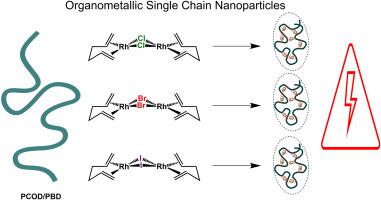Reactive & Functional Polymers ( IF 5.1 ) Pub Date : 2021-07-01 , DOI: 10.1016/j.reactfunctpolym.2021.104971 Victoria Kobernik , Ravindra Suresh Phatake , Jonathan Tzadikov , Ofer Reany , N. Gabriel Lemcoff

|
An approach towards the expansion of Rh(I)-containing single-chain polymer nanoparticles (SCNPs) using linear polymers and μ-halo(diene)Rh(I) dimers as cross-linkers in high dilution was explored. Initially, the effects of utilizing different anionic ligands, i.e., halides, together with various labile alkene ligands, such as ethylene, 1,5-cyclooctadiene and 1,5-hexadiene, on the stability and activity of the resulting Rh(I) cross-linking complexes were examined. While the ethylene complexes for bromide and iodide bridges resulted too unstable and the 1,5-cyclooctadiene ligand produced inert complexes, the 1,5-hexadiene ligands provided the proper equilibrium of stability and lability to achieve efficient polymer folding. Thus, a range of new organometallic nanoparticles could be obtained via a direct exchange between the 1,5-hexadiene labile ligands of the Rh(I) complexes, and the corresponding 1,5-hexadiene elements present in ROMP derived 1,5-polycyclooctadiene (PCOD) and 1,4-polybutadiene (PBD). Notably, SEC analysis of the single-chain nanoparticles both for PCOD and PBD revealed the expected decrease in the hydrodynamic radius (Rh) of the parent polymer, indicating that other anions can also be used as elements in the cross-linking moieties to form these organometallic nanoparticles. Moreover, all of the Rh-SCNPs displayed intrinsic semi-conductivities in the range of similar undoped organic conjugated polymers, expanding the possible uses of this methodology for many applications.
中文翻译:

通过与双核μ-卤(二烯)Rh(I)配合物链内交联的有机金属单链聚合物纳米粒子
探索了一种使用线性聚合物和μ-卤(二烯)Rh(I)二聚体作为高稀释交联剂来扩展含 Rh(I)的单链聚合物纳米粒子(SCNP)的方法。最初,利用不同阴离子配体的效果,即、卤化物以及各种不稳定的烯烃配体,如乙烯、1,5-环辛二烯和 1,5-己二烯,对所得 Rh(I) 交联复合物的稳定性和活性进行了检查。虽然溴化物和碘化物桥的乙烯配合物太不稳定并且 1,5-环辛二烯配体产生惰性配合物,但 1,5-己二烯配体提供了适当的稳定性和不稳定性平衡,以实现有效的聚合物折叠。因此,新的有机金属纳米颗粒的范围可以得到通过Rh(I) 配合物的 1,5-己二烯不稳定配体与 ROMP 衍生的 1,5-聚环辛二烯 (PCOD) 和 1,4-聚丁二烯 (PBD) 中存在的相应 1,5-己二烯元素之间的直接交换. 值得注意的是,单链的SEC分析纳米粒子既为多囊性卵巢疾病和PBD揭示了在流体动力学半径(预期减少ř ħ母体聚合物的),这表明其它阴离子也可在交联部分被用作元件以形成这些有机金属纳米粒子。此外,所有 Rh-SCNPs 在类似的未掺杂有机共轭聚合物范围内都显示出本征半导体,扩大了这种方法在许多应用中的可能用途。



























 京公网安备 11010802027423号
京公网安备 11010802027423号